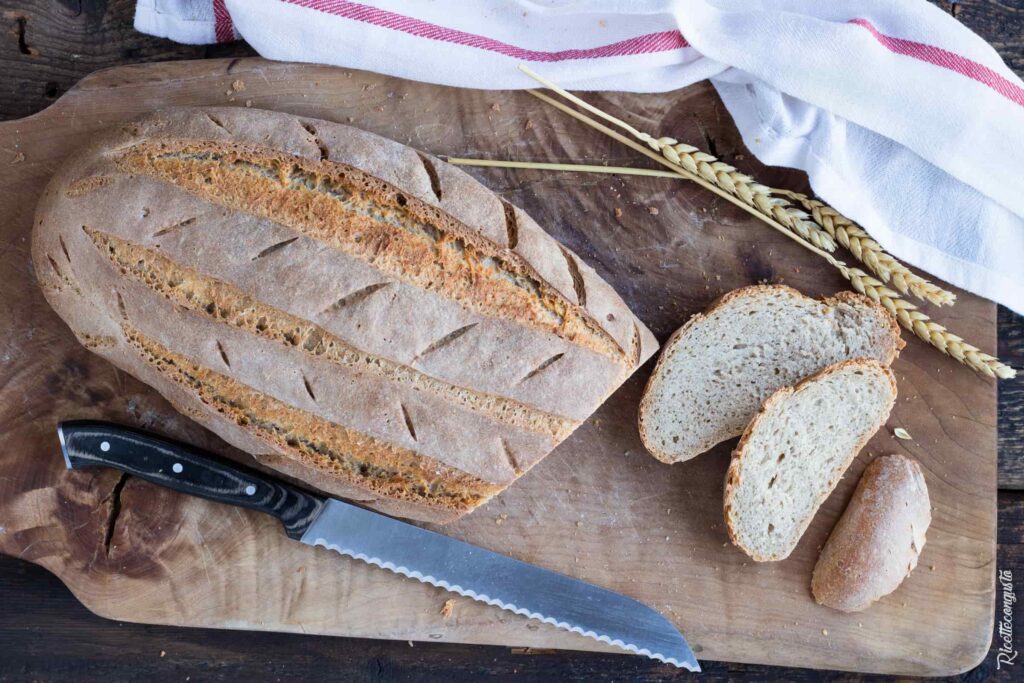15.11.2022
“Wheat field with cypresses” is a painting made in 1889 by Vincent Van Gogh, which represents the view of the countryside of Saint-Rémy, surrounded by shrubs and cypresses.
Such cornfield with cypresses by Van Gogh is a wonderful picture, which describes a typical Mediterranean environment…And an essential component of the French and broadly European and Mediterranean diet, the wheat with which bread is made.
This helps us to introduce a typical wheat of Calabria: Iermanu type.
CALABRIAN CORN
In Aspromonte (a mountainous zone of Calabria, in the very south of the region), “u granu jermanu“, or jermano, is the dialect name for rye, and it has been cultivated since ancient times.
With the use of this ancient Calabrian wheat, – with many beneficial properties, rich in vitamins, mineral salts and fibers, – Calabrian people produce a black bread, with a very rustic flavor, a little acid and with an intense aroma.

Iermano wheat was widely used throughout the South up to the 1950s, with this name (Iermano or Jurmano) that which in Italian is called rye is identified.
Introduced by the Germans during the First World War to create alcohol and bread, Jurmano wheat was well received in Calabria. From Aspromonte to Sila plateau there are still some farmers who have been carrying on the cultivar for over 50 years without stopping!
Being Calabria a rather mountainous land and therefore subject to very rigid winters, this German cultivar has been able to adapt well to our winter climates.
ITS SUCCESS: A VERY TASTY BLACK BREAD
Firstly, its rusticity. It is a cereal that even grows in the polar circle and reaches up to 4,000 meters of altitude.

Its peculiarity is mainly due to the health benefits: according to various scientific researches, rye thins the blood and prevents arteriosclerosis.
Rye flour, called in dialect iermano flour or iurmano flour, often mixed with durum wheat flour, is the main ingredient of an ancient product, the above mentioned black bread.
This black bread, whose production is very laborious, was produced with the luvato (mother yeast), which is prepared from the evening and then thrown in water and flour and covered with wool blankets.

The next day, the preparation begins with strength and effort, the dough of this bread is dense and viscous, but it is after baking that it keeps better and for a long time. At this point it is cut and cooked for a very long time, about two hours.
The Iurmano bread has some characteristics that distinguish it in a decisive way: the very dark color and the remarkable shelf life. It is a rustic bread, widely used by farmers, and therefore long-lasting.

SMAF LTD
Explore our products, coming from CALABRIA. Order the food and beverage products that allow you to explore the Mediterranean diet of a remarkable region. Surrounded by two seas and adorned with pine forests, mysterious villages, natural habitats, and rich biodiversity. Discover handcrafted delicacies that embody the soul of the land: sun-ripened fruits, premium olive oils, bold wines, artisanal cheeses, and traditional cured meats, all crafted with passion and authenticity.
A BIOLOGICAL PRODUCT
Organic Jurmano flour is 100% biological. It is produced with ancient Calabrian Jurmano or Jermano (Rye) wheat, grown organically by local companies, and it is characterized by a low protein content that makes it suitable even for people with food intolerances (who have digestive disorders in the presence of high percentages of gluten).
Furthermore, the stone grinding, avoiding the overheating of the grain, preserves the wheat germ without altering its properties, and the flour preserves all the nutritional substances it is equipped with, among which the vitamins of group E, B and mineral salts such as phosphorus, potassium stand out, and magnesium.

The wheat of the Calabrian mountain areas, after the long decline that began after the war, is now finally subject to widespread re-evaluation thanks to its excellent nutritional properties.
In addition to bread making, Jurmano flour can be used for the production of pasta: maccarruni, for example.

